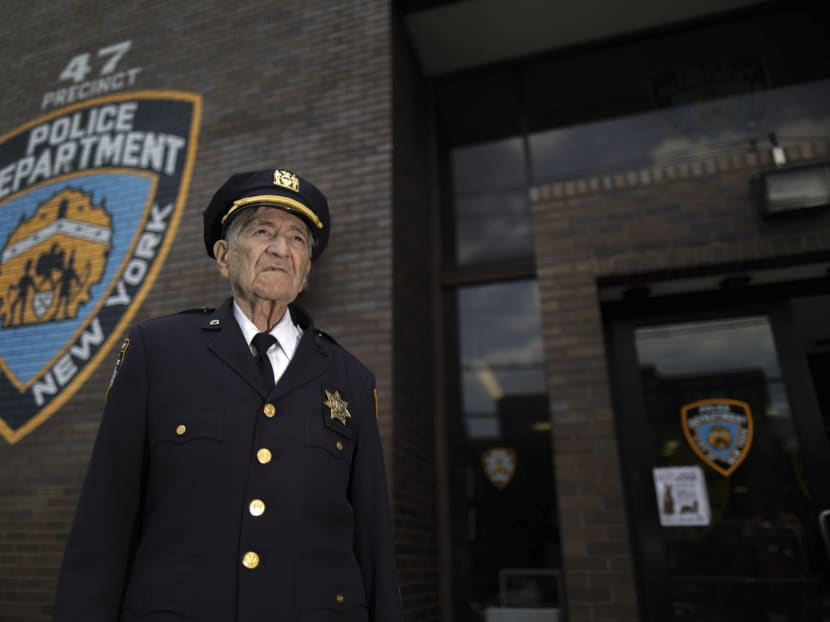No rest for a man, 92, whose work went to the Moon and back
NEW YORK — Mr Gene Fastook, who helped make it possible for humans to walk on the moon and return to Earth to tell the tale, now begins most days in a McDonald’s on White Plains Road in the Bronx, gabbing with other military veterans.

Gene Fastook, a police auxiliary captain in the Bronx, who is the department’s second-oldest person, in New York, July 12, 2017. Fastook, who helped make it possible for humans to walk on the moon and return to Earth to tell the tale, is still on the go with the police auxiliary in the Bronx. Photo: The New York Times
NEW YORK — Mr Gene Fastook, who helped make it possible for humans to walk on the moon and return to Earth to tell the tale, now begins most days in a McDonald’s on White Plains Road in the Bronx, gabbing with other military veterans.
In the afternoon, Fastook drives over to the 47th Precinct station house, where he serves as a captain in the police auxiliary, a volunteer uniformed reserve that he joined in 1981. At 92, he is the second-oldest person serving in the New York Police Department.
Hunched over a logbook at his desk in the 47th last week, Mr Fastook followed his finger down the page to see who had been on duty and who would be reporting in. The same active, restless spirit drove him, at age 17, when he was a senior at Brooklyn Tech high school, to forge his mother’s signature and enlist in the Navy.
He served in the Pacific aboard landing ship tanks, which get cargo and vehicles right to the shoreline. “They were called LSTs, with a top speed of 10 knots,” Fastook said. “We said it stood for *Low slow target.’”
Prompted by his sons, Eddie and Gene Jr, Mr Fastook recalled bits of his careers at sea and in the skies.
One torpedo that seemed to be headed directly for his LST missed. “We had such a low draft, it went under us and came out the other side,” Mr Fastook said. Later, when he was aboard the destroyer Luce, which supported landings on Okinawa, Japan, in 1945, a kamikaze plane sunk the ship. “I was in the stern,” Mr Fastook said. “At general quarters, you had to have your life vest. They had regular small boats picking you up.”
His sons produced a scrapbook of news clippings. One photo showed MacArthur landing in the Philippines, but Ed Fastook pointed to a figure off to the side. “There’s Dad,” he said.
“Tell him about MacArthur landing,” Gene Jr urged his father.
“When he first got there, they carried him in so he wouldn’t get his feet and shoes wet,” Mr Fastook said. “After the newsreels got there, he went back out and walked in.”
(How and why MacArthur’s feet got wet are not matters of settled history. The general landed on Leyte in the Philippines in October 1944, having promised two years earlier to return and push back a Japanese invasion; he also came ashore on Luzon in January 1945. On both islands he walked through the surf, though whether out of necessity or theatricality is difficult to discern from a distance of 73 years.)
After the war, the government hired Fastook to test military equipment. Before finishing college, he returned to active duty in the Korean War, and fought behind MacArthur in the Battle of Inchon.
Back in the United States, he inspected materials from contractors for the space program, including the spacesuits for astronauts, which were made by the International Latex Corp. This, he noted, was the same company that made Playtex bras. His scrapbook includes pictures of him in a laboratory with one of the lunar modules, built by Grumman on Long Island. The modules brought astronauts to the surface of the moon, and then returned them to the larger command service module in lunar orbit for the voyage back to Earth.
Eddie Fastook, a former police officer who is the director of security for the New York Yankees, said he was at a baseball game in Cleveland a few years ago when John Glenn, the astronaut and senator, threw out the first ball.
“I introduced myself to him as Gene Fastook’s son, and he said, “Are you the older one or the younger?’” Mr Fastook said.
His father and mother, Lydia Antonia, hosted neighbors who watched films made by the space program. Lydia Fastook, to whom Gene was married for 66 years, died two years ago.
Among those the elder Fastook said he’d encountered was Wernher von Braun, who developed rocket technology for the Nazis and surrendered to US troops rather than the Soviet Union. Von Braun’s expertise became the foundation of America’s space program.
“He wanted to start a whole line of spacecraft with families on each one, and then just keep going until the end of space,” Fastook said. “Which is interesting. Where does space end?”
As he got up to leave the auxiliary police office, he noticed that a cable television box was illuminated, though the TV screen was off. He fiddled with the remote until the light went out. His two sons looked at each other and nodded.
“He can’t leave anything switched on,” Eddie Fastook said. “He’s saving money for the Police Department.” THE NEW YORK TIMES






